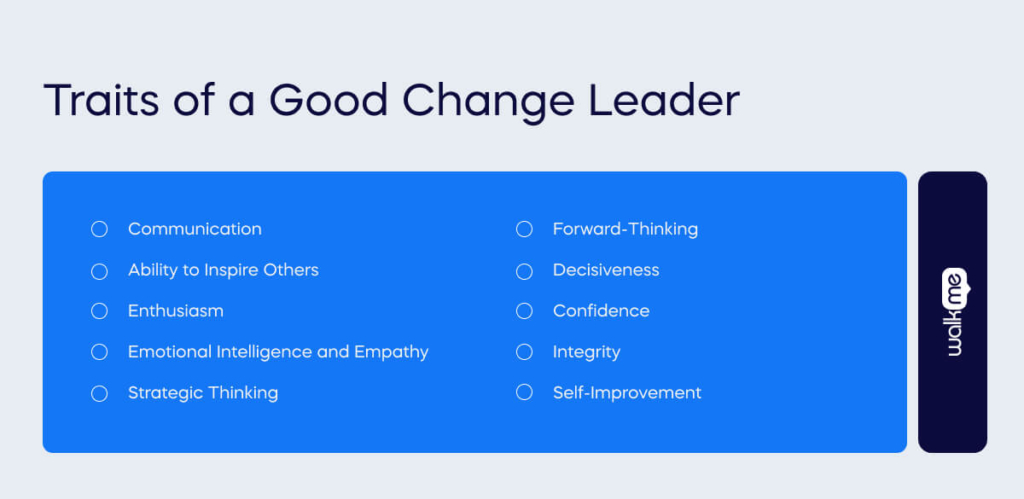A good change management leader must do a few things – envision change, embody it, and propel it forward.
But that’s no easy task, of course…
Also, it’s not always easy to pin down the traits that make a great leader.
However, leaders with the right traits can better:
- Fulfill their duties as change leaders
- Get others to follow them
- Successfully accomplish their change management goals
To start, it pays to understand what sets change management apart from other disciplines.
Duties of a Change Management Leader

In change management, leaders have specific goals.
They must:
- Create a vision for change. The vision for change is often developed by the change leader. This vision defines what the organization will look like after the change project is complete. It is this vision that stakeholders must strive towards during the change program.
- Develop a story for change. With change managers, good leaders should also craft a story for change. This story acts as a map during the change process. This journey map defines the transition between “before” and “after,” offering a narrative that people can easily understand.
- Embody and embrace change. Change leaders are the first to embrace change. By embodying their change, they provide an example for others to follow. If leaders don’t embody change before others, then it is likely that no one will follow them.
- Earn support and trust. Leaders lead because others follow them – they don’t simply mandate change. With the right emotional traits, leaders can earn trust instead of giving orders.
- Propel change forward. Change management leadership must also actively propel the change forward. They must define agendas, be exacting, overcome barriers to organizational change, and push teams when necessary.
Every change project is different, so the duties of change leaders can also differ.
However, for change programs to succeed, it’s critical for somebody – or a few people – to adopt change leadership duties.
Traits of a Good Change Leader

Now that we understand those duties, we can explore what it takes to demonstrate genuine change leadership.
Naturally, these traits can take time to cultivate … but they can only be cultivated by applying them.
Let’s start with the most important change management skill:
1. Communication
Communication has been named the most important change management skill.
It is fundamental in all areas of business, of course. But in change management it can determine the outcome of a project.
Good communication inspires employees, earns their support, builds trust, and increases the growth potential for change programs.
However, communication is a two-way street – it also involves listening.
2. Ability to Inspire Others
Inspiration can be accomplished through:
- Enthusiastically embracing change
- Proactive communication
- Offering support and encouragement
- Showing the benefits of change
To name a few.
Successfully inspiring others can greatly impact your success as a leader.
3. Enthusiasm
Positivity and enthusiasm are also traits that fuel success.
Sincere enthusiasm makes others want to be around you and it inspires them to follow your lead, as just mentioned.
However, insincere enthusiasm is transparent and can have the opposite effect.
4. Emotional Intelligence and Empathy
In the same vein, emotional intelligence and empathy are great leadership qualities.
These qualities improve your ability to understand what people are feeling and thinking, even if they don’t say it.
In change management, this can be invaluable.
Among other things, it can help you gauge people’s perception of the change program and its health.
5. Strategic Thinking
Along with emotional qualities, leaders must also be business-savvy.
Strategic thinking, for instance, helps the change management leader be impartial, logical, and objective.
This helps them design appropriate strategies for executing change, overcoming barriers to change, and dealing with day-to-day change management activities.
6. Forward-Thinking
Like an entrepreneur, a good leader has a vision for the future.
This forward-thinking mindset helps leaders:
- Stay focused on the goal, instead of becoming mired in minutiae
- Communicate clearly about their vision for change
- Design digital change strategies that will work in today’s modern economy
Part of the reason change leaders are leaders is precisely because they can think ahead – this is why they can create change programs in the first place.
7. Decisiveness
Another essential quality for leaders is decisiveness.
Decision-making – and the risks that come with it – are a requirement for leaders.
Because this responsibility comes with leadership, anyone in a leadership position should cultivate decisiveness.
8. Confidence
In every area of business, confidence sells.
Words such as “decisiveness,” “bold,” and “confident” are usually associated with leaders.
Traits such as these inspire the same in others.
On top of that, they prevent unwanted behaviors, such as self-doubt, questioning one’s own actions, timidity, and so on.
9. Integrity
A leader should be sincere and have integrity.
Those who have this quality will earn trust and support.
A lack of integrity, however, builds mistrust and decreases support.
10. Self-Improvement
Finally, leaders must recognize that they aren’t perfect.
There is always room for self-improvement.
Being a humble lifelong learner isn’t just good for personal growth, it also improves one’s ability to lead.

